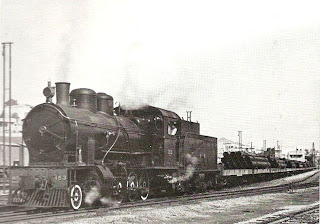I love a train! Riding the train makes me nostalgic for a bygone era I sadly never knew.
The Hejaz Railway was built by the Ottomans between 1900 and 1908, mainly to make it easier to make the pilgrimages to the Muslim holy places in Saudi Arabia. As an added bonus, it gave the Ottoman Turks better control of their far-flung empire. The main line linked Damascus to Medina; a distance of 1,320 km. It passed through Transjordan in Az-Zarqa, Al-Qatranah, Amman and Ma’an before reaching northwestern Arabia the Hejaz region. It was built as an extension of the already existing line between Istanbul and Damascus. Construction fell short of the planned destination of Mecca when the outbreak of the First World War interrupted construction work just as it reached Medina. The primary purpose of the Hejaz railway was to establish a connection between Constantinople and Hejaz in Arabia, the site of the holiest shrines of Islam and the holy city of Mecca, the site of the annual Hajj pilgrimage.
A pilgrimage from Damascus by camel required 40-50 days. As they progressed toward Medina and Mecca, the pilgrims faced many risks including robbery, floods and epidemics in addition to the difficulties and suffering one might expect from such a journey. Sultan Abdel Hamid made the decision to establish a rail line linking Damascus to the holy sites.
The railway replaced the ancient caravan route that was formerly used to transport goods to and from Damascus and Arabia. The unhappy caravan traders saw this new form of transport as a serious threat to their livelihoods, and they made many attempts to disrupt its construction.
Construction, maintenance and security of the line required the services of some 5,000 Ottoman soldiers. The entire operation was enormously difficult, with unpredictable and often hostile local tribesmen, not to mention the difficult terrain. Some areas were very soft and sandy while others were solid rock. There were water shortages to contend with, and variations in the terrain itself made construction difficult. The extremely hot weather coupled with dust and sandstorms and the occasional flash floods washing away bridges and banks threatened the operation even more.
In September, 1900 the Sultan called for Muslims all over the world to collect donations for the construction of the railway. His call received enthusiastic response and support. The cost of the project was estimated at around 5 million Ottoman Golden Lire. In addition to donations, a special tax on all citizens to be served by the train and revenues from the sale of special Ottoman State stamps financed the new line. The costs were reduced by donations of materials from areas adjacent to the line, volunteer laborers, and the employment of members of the army.
Within four years of completion in September 1908 the Hejaz Railway was seeing about 300,000 passengers a year. Not pilgrims only; the Turkish government had begun transporting troops and supplies. During the War (1914-18) a great many attempts were made to disrupt the line and slow the advancing Turkish Army.
The famous British military strategist, TE Lawrence working with the combined Arab forces mined the tracks and derailed several troop trains and carriages. As a result of their sabotage, the track between Ma’an (Jordan) and Medina (Arabia) was irreparably damaged.
The famous British military strategist, TE Lawrence working with the combined Arab forces mined the tracks and derailed several troop trains and carriages. As a result of their sabotage, the track between Ma’an (Jordan) and Medina (Arabia) was irreparably damaged.
At the end of the war, the operative sections of the railroad were taken over by the relevant Syrian, Palestinian and Transjordan governments. Here is an excellent clip about the Hejaz Railway:
After the fall of the Ottoman Empire, the railway never reopened south of the Jordan-Saudi Arabia border. An attempt was made in the mid 1960s, but was abandoned due to the Six Day War in 1967.
In 1952 the Hejaz Jordan Railway was founded and still administers the Jordanian line and invests its real estate properties.
The Jordan Hejaz Railway Museum is located in the Mahatta district, about 2 km east of downtown. The opening hours are Sunday-Thursday 8 am to 2 pm. More information can be obtained by phoning +962 16 489 541 3.
Today the Corporation operates regular passenger trips between Amman and Damascus on Mondays and Thursdays. The train leaves Amman at 8 am and returns from Damascus at 8 am. Trips via diesel trains for school students and families and tourist trips via steam locomotive are available. The passenger capacity on either of the trains is 350.
The southern portion of the railway is used solely by the Aqaba Railway Corporation whose only customer is Jordan Phosphate Mines Company. Phosphate, which is our largest export, is transported from the mines in El-Hasa, Al-Abyadh and Shidyia to Aqaba for shipping. Jordan is the third largest phosphate exporter in the world. Enjoy this video clip of the phosphate trains
























